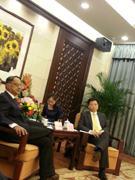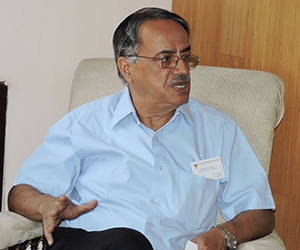Tale of Two Chinese Cities
The second part of the trip involved a visit to Shenzhen and Guangzhou; one representing the new resurgent, pulsating China throbbing with economic activity and the second depicting both the old and new elements. Guangzhou, a traditional Chinese coastal city has transformed itself into a new modernized metropolis which is the capital of one of the wealthiest provinces of China. While Shenzhen has made rapid strides in the knowledge age industries Guangzhou is known for both being a manufacturing and trading hub. Guangzhou also houses some of the high end technical establishments like the National Super Computer but it is Shenzhen that is known for innovation and high tech enterprises. At the national level while Beijing and Shanghai are placed as first and second major cities based on a number of indicators Guangzhou and Shenzhen come second and third. But then Shenzhen’s fast paced development over last three and half decades has given rise to the possibility of it replacing Guangzhou as the third major city in mainland China.
Therefore, it was very apt that the Indian delegation of strategic experts and journalists was taken to these two cities of Guangdong province in order to acquaint them with the extent of modernization and development that has taken place in China. The first stop was Shenzhen Museum which showcases the transformation of a small fishing village to the current scenario in a period of slightly over three decades. A city of about 10 million people, its per capita GDP is 22,000 US dollars for 2014 which is more than the per capita GDP Guangzhou (19,000 USD) as also the entire mainland China’s other cities. The museum depicts the history of reforms and opening up of Shenzhen first as a Special Economic Zone and thereafter its expansion by almost four times its original size area wise.
Shenzhen houses top of the line high tech enterprises in China specializing in ICT, automobiles, green energy, electronics, mobile phones and its parts among many other knowledge age products and services. Huawei, HTC, Toshiba and BYD have their facilities and establishments here. BYD Auto is considered as the most innovative national brand that leads the field of electric vehicles with new technologies. Thus visit of the delegation to Huawei and BYD Auto was meant to show the areas where China has made large strides in high end technologies and products.
Huawei: ‘Make in India’ and Cyber Security Concerns
Huawei is a leading ICT solution provider with revenue of 46.5 billion USD in 2014; it claims to support the needs of one third of the world’s population. With its HQ in Shenzhen it has steadily increased its presence in India since 1999. Its first R & D centre in India was setup in Bangalore which is now ‘cloud’ based; there is another centre in Gurgaon whereas it has manufacturing facility in Chennai. Joe Kelly, the Vice President and his team briefed the delegation about Huwaei’s activities in India and its plans and contribution towards ‘Make in India’ campaign. Digital connectivity and broadband network for all is the major objective of the company. He also explained how based on Huwawei’s manufacturing activity in Chennai 115 small size local companies even got listed because of partnership with Huawei. The company was very keen to take part in Prime Minister Modi’s plan to build 100 smart cities across India that would have high-tech communication capabilities. Pointing out the seriousness with which Huwaei looks at CSR obligations the case of Huawei along with Bharti Telecom restoring the damaged telecom infrastructure during J & K floods was recalled.
When questioned about security concerns and suspicions in India (because of its connections with PLA) regarding the telecom equipment of Huawei it was pointed out that there was no such thing as a Chinese, US or some other country specific product as the supply chain encompasses multiple sources, for instance the software could be sourced from India and the hardware could be from a number of other countries. As cyber security is an issue of intense interest to both customers and governments the company has committed that it will collaborate with all the stakeholders in ensuring that there is no place for breach of security. In any case, it is bad for business. Processes that are both externally and internally focused have been introduced that in effect would ensure comprehensive cyber security. Compliance with local laws and regulations, verification of equipment by independent third parties and monitoring of digital signatures were some of the elements of this process.
In fact, in 2013 Huawei had taken out a white paper on cyber security authored by John Suffolk, previously Chief Information Officer in UK’s government and later employed by Huawei (presently, he is Senior Vice President). Apparently, he had been instrumental in assuaging the security apprehensions of the British government in allowing access of Huawei to Britain’s telecom sector.
Huawei is in to touch with Department of Electronics and Information Technology and has made first telecom supplier proposal and largely the Indian government seems inclined to go ahead after cyber security assurances and third party verifications. According to Indian media the government is looking to create adequate testing facilities to screen equipment for embedded malware before clearing a proposal by Huawei to set up a Rs 25-crore manufacturing facility at an SEZ in Chennai. This new approach is said to be under consideration by the ministry in consultation with the National Security Council Secretariat (NSCS) and intelligence agencies.
Build Your Dreams (BYD): Clean and Green Solutions
That is exactly what BYD Auto has been doing after its establishment in 2003. Basically an auto brand that integrates advanced technologies from IT industry and is into associated software development it is producing highly intelligent vehicles. In addition it sees itself as a pioneer in new energy solutions and has developed green products such as solar farm, energy storage station, electric vehicles, LED and electronic fork lift etc. It is one of the largest private auto manufacturer that is aiming to expand its share of the electric and hybrid cars and vehicles; as its sale pitch the BYD rep briefed the visiting Indian delegation that it has sold electric buses and taxis to the US and South East Asian countries among other markets. In fact, Shenzhen city has over 500 E6 model electric cars operating as taxis along with recharge stations.
Looking at India’s ambitious plans for solar energy and green products there is a considerable potential for doing business with India in the shape of setting up joint ventures in India. Though some of the green products and production of solar energy was costlier it would need government subsidy as is being done in many countries to promote clean and green energy solutions. In any case, last year in February, Bangalore Metropolitan Transport Corporation and BYD launched a programme that is expected to change air quality over Bangalore. It is at that time the first long-range, all-electric bus of BYD arrived in Bangalore; the bus achieves up to 24 hours of service on a single night-time charge which is longer than any other electric bus in the market today. Success of this initiative is expected to have a cascading effect across the other Indian urban centers that are afflicted with air pollution and thus are looking for clean energy solutions.
Shenzhen University and Cultural Cooperation
In addition to technical and scientific progress reflected by the success of the abovementioned companies Shenzhen University established in 1986 has also come in for recognition at the international level for its academic achievements. It has a Centre for Indian Studies that has courses in Indian literature, comparative studies of Chinese and Indian poets and their works, offers courses in Indian culture, and Indian classics. The Centre has also hosted international conference on Ramayana besides many other social and cultural events that bring India and China together. It also boasts many internationally recognized Chinese Indologists who are well known and well respected in India e.g. Prof. Tan Chung who propagates that with India and China both being civilisational powers it is the geo-civilisation narrative that should dominate the bilateral relationship rather than the geo-political or the geo-strategic discourse.
Prof. Yu Longyu, Director of Center for Indian studies made a presentation on “The Belt and Road” and the New Opportunity for China-India Cooperation. He emphasised on the mutual benefits that can be derived from OBOR initiative that covers several aspects of cultural and economic cooperation. While China has more than ten such centers teaching Hindi and studying India we have been lax in encouraging studies about China in India. This needs to be rectified in an earlier timeframe.
Another visit was to Shenzhen TV where they showcased their virtual studio and explained to the visiting delegation the positive stories they were broadcasting especially about Sino-Indian relations. Interviews with Indian experts and journalists were designed to promote Sino-Indian relations; stress being on convergences rather than divergences. Cooperation with Indian TV entities was possible based on similar lines as MOU signed between CCTV and India’s Doordarshan TV during PM Modi’s visit.
Travelling from Shenzhen to Guangzhou in High Speed Rail
Most invigorating experience during the sojourn to China was that of travelling by the High Speed rail from Shenzhen to Guanghzhou. The journey at the speed of over 300 kms per hour that took only about 30 minutes to cover a distance of 135 kms was smooth. There were no swaying movements or any other uncomfortable jerks, stops or starts. The railway stations at both ends looked more like airports and were pictures of skillful organization, efficiency and cleanliness. Though in terms of Indian purchasing power the cost of ticket of 100 RMB (INR 1000) could be considered as bit steep but this was not considered so by the Chinese standards.
Guangzhou: Capital of Guangdong Province
Last stop of delegation’s visit was Guangzhou, the capital of Guangdong province. With a population of around 107 million the province posted a GDP of 1.06 trillion US dollars in 2014. Now this is almost half of India’s total GDP in absolute numbers. These figures and other information were given out during briefing by Mr. Wu Ken, Deputy Secretary General of Guangdong and later on by Mr. Li Jian DDG of Guangdong Foreign Affairs office along with a number of other senior officials from Planning and Industry Policy Division, Trade, Commerce, Agriculture and tourism Departments among some others. Guangdong has been posting the highest GDP amongst the Chinese provinces for over 25 years. While the structure of Guangdong’s economy (percentage of population in primary sector: 4.7, secondary sector: 45 and tertiary sector: 48.2) indicates that the province is highly industrialized and increasingly moving towards becoming a knowledge age society yet it has income disparities. Rural population i.e. 34 percent of 107 million, however, had a per capita income of 12,246 RMB (approx 2000 USD) which was much less than the average per capita income of around 10,000 USD.
The government officials explained the various cooperative arrangements that already exist between both sides and the potential for enhancement and diversification. Trade figures between Guangdong and India were highlighted. Recommendations were made by Indian side to allow access to Indian pharmaceutical, IT and agriculture products and services. There was also potential for enhancing cooperation in area of energy and establishment of industrial parks (as proposed during PM Modi’s visit). Increased cooperation between chambers of trade and commerce of both sides was mooted. Interestingly, cooperation in terms of anti-corruption drive and learning from each others’ experiences was viewed as another area for sharing ideas. The Guangdong officials also mentioned that a 21st century Maritime Silk Road Expo is being organized soon to push our two way investment and trade. While Guangdong and Gujarat had become sister provinces and Guangzhou and Ahmadabad as sister cities during President Xi’s visit to India last year it was time to cement the relationship further.
Conclusion
The overall objective of the organizers in acquainting the visiting delegation with the advances made by China both in terms of development, achievements in the field of infrastructure and the fast paced economic growth was amply brought home to the visitors. The OBOR and explanation of the concept and the mutually beneficial aspects of was done in almost all the briefings that were undertaken by the government officials and even by non-government entities. Throughout the visit the points about bilateral strategic dissonance were only discussed almost in passing; the stress was laid over and again on enhancing economic cooperation. Obviously, China sees in India an emerging market opportunity that can absorb Beijing’s gargantuan manufacturing and other surplus capacities. Recently, Chinese ambassador to India Le Yucheng has said that China’s latest manufacturing campaign 'Made in China 2025' can be aligned with India’s 'Make in India' initiative. How will that be done or how can it be done is another question for another day.
Published Date: 29th June 2015
(Disclaimer: The views and opinions expressed in this article are those of the author and do not necessarily reflect the official policy or position of the Vivekananda International Foundation)










Post new comment